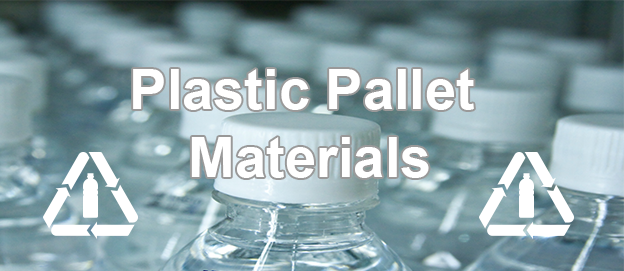Plastic Pallet Materials
Plastic Pallets are made from a variety of different materials. Each have their own benefits and challenges. When selecting the right plastic material for your pallet’s application, there are two main and opposing aspects to consider; impact resistance & rigidity. In general, these aspects are inversely correlated.
In other words:
The more rigid a pallet is, the less impact resistance it possesses.
The less rigidity a pallet has, the more impact resistance it possesses.

Resistance and Rigidity
A pallet that is very rigid will typically have poor impact resistance. Similarly, a plastic pallet with high impact resistance will usually be less rigid.
Popular Plastic Pallet Materials
As is true for many of our blog features, there is no right or wrong pallet, only what is best for your conditions.
With that in mind, here are some of the more popular plastic pallet material types:
High Density Polyethylene Pallets (HDPE Pallets)
High Density Polyethylene (HDPE): This is by far the most common material used to mold plastic pallets. Milk jugs are the single largest use of HDPE and is known as a very versatile resin. It is also very inexpensive compared to other plastics, especially recycled resin. It offers plastic pallets a middle of the road compromise between impact resistance and rigidity.
HDPE Pallet Benefits:
- Impact Resistance
- Resistance to Freezing
- Highly resistant to strong acids and bases.
In one sentence: HDPE is the most common, versatile, and cheapest material used amongst the different types
In one sentence: HDPE is the most common, versatile, and cheapest material used amongst the different types of plastics.
Pro Tip: HDPE pallets absorb little to no water, making them easy to clean and store!
Polypropylene Pallets (PP Pallets)
Polypropylene (PP): PP is the second most widely use resin used in plastic pallets. It is much more rigid but lacks the impact resistance of HDPE. It’s also usually more expensive that HDPE.
PP Polypropylene Pallet Benefits:
- Stronger than HDPE
- More Rigid than HDPE
- Excellent crush recovery – more resilient!
In one sentence: PP costs more to produce and is not as commonly used, as much as HDPE.
Pro Tip: Polypropylene it is extremely resistant to chemical solvents, acids, and bases!
Polyolefin Pallets (PO Pallets)
Polyolefin (PO): PO is basically a catch-all for plastic materials that don’t fall into any of the other categories. For our purposes, PO is a proprietary blend of HDPE, PP, and cellulose that is found in many of our plastic pallets. It is sometimes referred to as ACM (Advanced Composite Material). The benefits are very high rigidity and low cost, but is difficult to mold, is very brittle, and cannot get wet. The cellulose expands and leeches the carbon black used to color the pallets. This type of plastic is often used in the production of one time use pallets or export pallets, this means that once they are sent out there will not be an expectation to have them returned.
PP Polyolefin Pallet Benefits:
- Lower cost pallets
- Good option if pallets do not need to be returned or reused (export, one way pallets)
In one sentence: PO is a plastic blend that is common, but cannot get wet and is harder to manufacture.
Pro Tip: Don’t expose polyolefin plastic pallets to water!
Fiberglass Pallets
Fiberglass is a recent entry in plastic pallet materials. There are only a couple manufacturers in the world with this capability and they employ proprietary methods. Typically, the pallets are coated with clear finish to seal in the glass fibers. This adds significant cost but produces a pallet that is extremely rigid and has high impact resistance. In addition, it has excellent fire retardant properties without any added fillers.
Fiberglass Pallet Benefits:
- Extremely flex resistant
- Extremely Impact-resistant
- Naturally fire-retardant
In one sentence: Fiberglass pallets consist of a glass and plastic mixture, they are very strong, but can be very costly.
Pro Tip: Fiberglass pallets allow lots of stacking capabilities, so tack them up to utilize floor space!
Share your Comments!
What type of plastic pallets best suits your needs?
What are your opinions on the different pallet materials currently on the market?
We’d love to hear from you – please share thoughts in the comments below.
Need Help Selecting A Pallet?
Our Plastic Pallet Experts are happy to help you find the right plastic pallet and send you a quote that includes shipping costs. Please contact to find the perfect pallet at the best price.
About Robin Kiefer
Robin Spencer Kiefer connects customers with solutions and products. Robin is the Digital Marketing Manager of One Way Solutions.


 Robin Kiefer
Robin Kiefer  June 6, 2018
June 6, 2018 